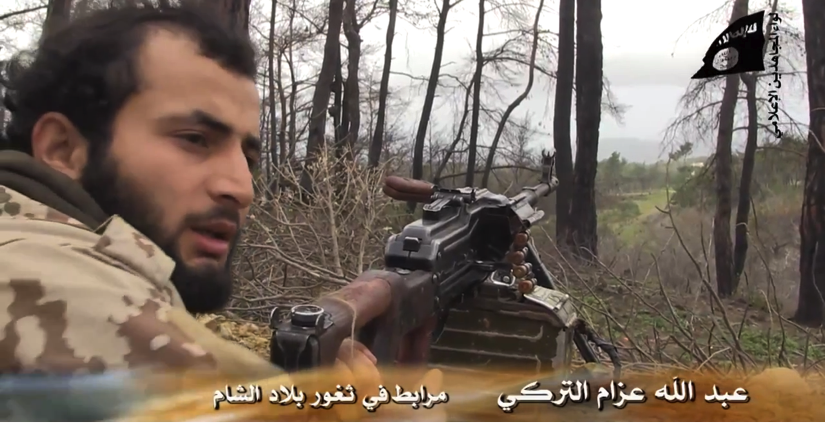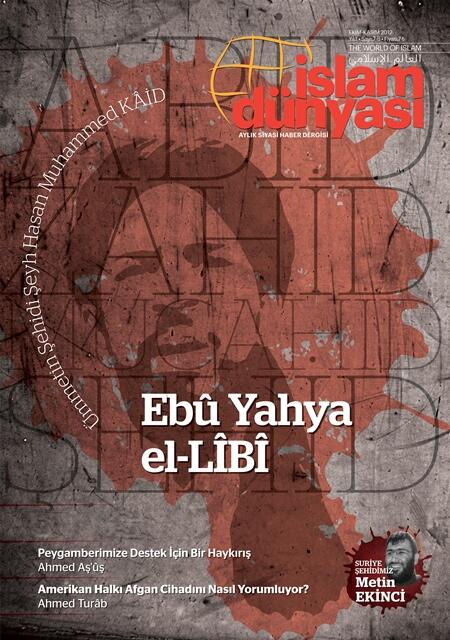
Click the following link for a safe PDF copy: Shaykh ‘Aṭīyyat Allah al-Lībī — “Indisputable Answers for Turkish Jihādīs”
____________
To inquire about a translation for this release for a fee email: [email protected]
Category: Turkey
GUEST POST: "Turkish Fighters in Syria, Online and Off"
NOTE: As with all guest posts, the opinions expressed below are those of the guest author and they do not necessarily represent the views of this blogs administrator and does not at all represent his employer at the Washington Institute for Near East Policy.
Jihadology.net aims to not only provide primary sources for researchers and occasional analysis of them, but also to allow other young and upcoming students as well as established academics or policy wonks to contribute original analysis on issues related to jihadism. If you would like to contribute a piece, please email your idea/post to azelin [at] jihadology [dot] net.
Past Guest Posts:
Mark Youngman, “Book Review of David Malet’s “Foreign Fighters: Transnational Identity in Civil Conflicts”,” June 20, 2013.
Hazim Fouad, “Salafi-Jihadists and non-jihadist Salafists in Egypt – A case study about politics and methodology (manhaj),” April 30, 2013.
Daveed Gartenstein-Ross and Tara Vassefi, “Perceptions of the “Arab Spring” Within the Salafi-Jihadi Movement,” November 19, 2012.
Jack Roche, “The Indonesian Jamā’ah Islāmiyyah’s Constitution (PUPJI),” November 14, 2012.
Kévin Jackson, “The Pledge of Allegiance and its Implications,” July 27, 2012.
Behnam Said, “A Brief Look at the History and Power of Anasheed in Jihadist Culture,” May 31, 2012.
Jonah Ondieki and Jake Zenn, “Gaidi Mtaani,” April 24, 2012.
Joshua Foust, “Jihadi Ideology Is Not As Important As We Think,” January 25, 2011.
Charles Cameron, “Hitting the Blind-Spot- A Review of Jean-Pierre Filiu’s “Apocalypse in Islam,” January 24, 2011.
Daveed Gartenstein-Ross, “Why Jihadi Ideology Matters,” January 21, 2011.
Joshua Foust, “Some Inchoate Thoughts on Ideology,” January 19, 2011.
Marissa Allison, “Militants Seize Mecca: Juhaymān al ‘Utaybī and the Siege of the Grand Mosque in Mecca,” June 9, 2010.
—
Turkish Fighters in Syria, Online and Off
By North Caucasus Caucus
Click here for a PDF version of this post
NOTE:
This piece provides a granular look at the backgrounds of Turkish citizens fighting in Syria, building on a recent article by Soner Cagaptay and Aaron Y. Zelin on the challenges Turkey may face in the future emanating from jihadis operating near Turkey’s southern border and the eventual return home of Turkish jihadis. While I have spent a considerable amount of time living, working and studying in Turkey, I am by no means an expert on Turkish jihadi groups or jihadi movements in general. I am a researcher on the politics of the Caucasus, but while researching foreign fighters in Syria from the Caucasus, I continually noted their engagement with Turkish jihadi material and felt it was an issue that needed further exploration.
INTRODUCTION
Over the last three decades, Turkish citizens have travelled to fight and die in conflicts both close and distant. Turkish citizens have fought in Iraq, Afghanistan (both against the Soviets and the United States), Bosnia, and the North Caucasus, sometimes occupying leadership positions in Islamist armed groups. For example, Cevdet Doger (aka Emir Abdulla Kurd) was second-in-command of foreign fighters in the North Caucasus before his death in May 2011.

Cevdet Doger and recovered Turkish identification tables, Source: sehidler.com
I will not venture to estimate how many Turkish citizens are fighting in Syria. In August 2012, Turkish journalist Adem Ozkose reported on the deaths of four Turkish fighters in Aleppo and said they were part of a group of 50 Turks fighting in that region. In the year since, it is conceivable that this number has grown along with Syria’s general population of foreign fighters.
SYRIA IN TURKISH ONLINE SPACES
There is a large amount of Turkish pro-jihadi material on Facebook relating to Syria. For example, the page, “Suriye İslam Devrimini Destekliyoruz,” (“We Support Syria’s Islamic Revolution”) has over 11,000 “Likes.” Al-Nusra Front (Nusret Cephesi in Turkish) and the Islamic State of Iraq and Sham (ISIS) both have Turkish language fan pages which are regularly shut down by Facebook but are always quickly reestablished. Turks interested in following jihadi activity in Syria are not wanting for online news coverage.
Just as Arabic-language material is translated and posted on Turkish-language sites, material from Turkish languages pages makes its way to Islamist users from other countries. For example, the pro-Islamist Turkish news website, Islah Haber, which regularly publishes news on Turkish fighter activity and deaths, uploaded an Arabic language video on 9 July 2013 that included several Turks speaking (with Arabic subtitles) about why they went to Syria. One fighter emphasized Assad’s killing of women and children and the hope of establishing a sharia-based state as a prime motivator.

The caption identifies him as “Abdullah Azzam the Turk, connected to Thughur Bilad al Sham,” Source: Islah Haber
YouTube videos are sometimes used in recruitment efforts. The Russian language website, fisyria.com, released a video on 03 July 2013 from Emir Seyfullah, an ethnic Chechen and then-spokesman of ISIS-affiliate Jaish al-Muhajirin wa Ansar. In the video, Emir Seyfullah speaks in heavily accented Turkish, calling for Turks to come help establish sharia in the land of Sham; his speech is intercut with footage of Syrian military jets on bombing runs. Jamestown’s Mairbek Vatchagaev wrote that Seyfullah is from the Pankisi Gorge region of Georgia. However, it is possible that he lived in Istanbul before the war in Syria. Many former fighters from the North Caucasus continue to live in Turkey. This has led to violence in the past, such as the September 2011 assassination of two former fighters, allegedly by Russian security services, in Istanbul’s Zeytinburnu neighborhood.

Screenshot of YouTube video about Turkish martyrs in Syria
The amount of material about Syria uploaded onto YouTube in all languages is nearly endless. However, one recent video provided insight into the extent of Turkish fighter involvement in Syria. On 05 July 2013, an account (now-deleted), associated with the Facebook page, “Suriye Devrimi Sehidleri,” (“Martyrs of the Syrian Revolution”) uploaded a video entitled, “Turkiyeli Sehidler” (Martyrs from Turkey). The video shows the images of 27 different alleged Turkish fighters killed in Syria.
Check out my new article at CNN co-authored with Soner Cagaptay: "Turkey’s Jihadi Dilemma"

In late May, the Turkish government uncovered a plan to use Sarin gas as part of a potential bomb attack in southern Turkey. Al Qaeda’s branch in Syria, Jabhat al-Nusra (JN), was allegedly behind the plot, and the subsequent arrests highlighted the increasing trouble jihadi radicals could pose for Ankara. Indeed, the longer Turkey turns a blind eye to jihadi rebels crossing its territory into Syria, the more likely there will be blowback.
The reality is that providing jihadists access to a neighboring country can result in unintended consequences as radicals ultimately bite the hand that feeds them, something Pakistan should have learned over Afghanistan, and Bashar al-Assad has discovered as Syria-backed al Qaeda elements from Iraqi territory have turned against the regime in Damascus.
Click here to read the rest.
Fursān al-Balāgh Media presents a new issue of The Islamic World Magazine #7-8
NOTE: For previous issues see: #6, #5, #4, #3, #2, and #1.
—

Click the following link for a safe PDF copy: The Islamic World Magazine #7-8
__________
To inquire about a translation for this magazine issue for a fee email: [email protected]
New statement from the Islamic Emirate of Afghanistan: "Communiqué About the Release of Turkish Captives"

The Islamic Emirate of Afghanistan released 4 out of the 8 Turkish prisoners showing its good will, human and Islamic sympathy and regard for the Muslim Turkish Nation who were apprehended sometime ago by Mujahidin of the Islamic Emirate. The remaining 4 persons will also be released in the near future.
The Islamic Emirate of Afghanistan anticipates that the Turkish government will reciprocally express its good will and will take such measures which will consequently result in bringing the Afghan and Turkish Muslim masses close to each other and amplification of the devout brotherhood between them.
Regard
The Islamic Emirate of Afghanistan
3/7/1434 A.H. (lunar) ——- 23/2/1392 A.H. (solar)
13/5/2013 A.D.
__________
Check out my new Foreign Policy piece co-authored with Daveed Gartenstein-Ross: "Uncharitable Organizations"

In 1997, employees of the Al-Haramain Islamic Foundation (AHIF), a Saudi-based charity, were mulling how best to strike a blow against the United States in East Africa. According to the U.S. Treasury Department, one employee indicated that the plan they hatched “would be a suicide bombing carried out by crashing a vehicle into the gate at the Embassy.” A wealthy foundation official from outside the region agreed to fund the operation.
The employees’ plans would go through several iterations, but AHIF would eventually play a role in the ultimate attack. In 1998, simultaneous explosions ripped through the U.S. embassies in Tanzania and Kenya — attacks eventually traced back to al Qaeda operatives. Prior to the bombings, a former director of AHIF’s Tanzanian branch made preparations for the advance party that planned the bombings, and the Comoros Islands branch of the charity was used, according to the Treasury Department, “as a staging area and exfiltration route for the perpetrators.” The ultimate result was deadly: 224 people killed and more than 4,000 wounded.
This was, of course, before the 9/11 attacks and the subsequent crackdown on wealthy Islamist charity organizations such as AHIF, which provided a large portion of the funding that made international terrorism possible. As a monograph produced for the 9/11 Commission noted, prior to 9/11, “al Qaeda was funded, to the tune of approximately $30 million per year, by diversions of money from Islamic charities and the use of well-placed financial facilitators who gathered money from both witting and unwitting donors.”
But despite all the efforts made to shut down such groups, Islamist-leaning international charities and other NGOs are now reemerging as sponsors of jihadi activity. In countries like Tunisia and Syria, they are providing the infusion of funds that have allowed extremist groups to undertake the hard work of providing food, social services, and medical care. Jihadists, meanwhile, have discovered that they can bolster their standing within local communities, thereby increasing support for their violent activities. And governments are struggling to keep up.
Click here to read the rest.
Fursān al-Balāgh Media presents a new issue of The Islamic World Magazine #6
NOTE: For previous issues see: #5, #4, #3, #2, and #1.
—

Click the following link for a safe PDF copy: The Islamic World Magazine #6
_________
To inquire about a translation for this magazine issue for a fee email: [email protected]
Fursān al-Balāgh Media presents a new issue of The Islamic World Magazine #5
NOTE: For previous issues see: #4, #3, #2, and #1.
—

Click the following link for a safe PDF copy: The Islamic World Magazine #5
__________
To inquire about a translation for this magazine issue for a fee email: [email protected]
Ṣawt al-Islām presents a new video message from Ḥizb al-Islāmī al-Turkistānī [Turkistan Islamic Party]: "Advice to Our Muslim Brothers in Turkey"

_________
To inquire about a translation for this video message for a fee email: [email protected]
Fursān al-Balāgh Media presents a new issue of The Islamic World Magazine #4
NOTE: For previous issues see: #3, #2, and #1.
—

Click the following link for a safe PDF copy: The Islamic World Magazine #4
__________
To inquire about a translation for this magazine issue for a fee email: [email protected]
